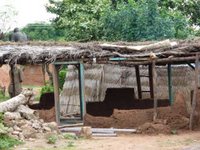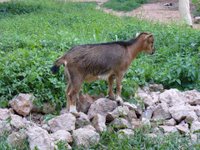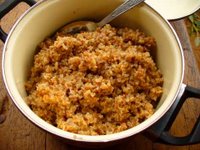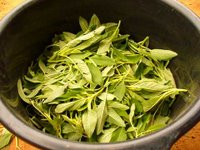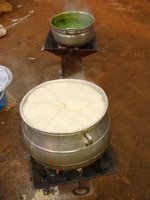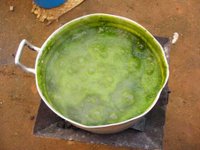One of the biggest adjustments one must make upon entering Ghana is to the pallette, and consequently, the entire digestive tract, with which many battles are fought in the first weeks of integration.
Ghana's food choices are many, which is a shock considering the few food items it imports and the scarcity in its selection of locally grown and produced goods.
With the basic crops consisting of cassava, maize, yams, groundnuts, and a few other legumes, the basic diet of the Northern Ghanaian is formed. With the addition of readily avaiable meats such as goats, cow, guinea fowl and chicken, and seasonal fruits such as mangoes, watermelon, pineapple and plantains, there is an enormous offering of products which cater to breakfast, dinner and everything in between (like lunch!).
TAKE MAIZE, FOR EXAMPLEMaize, or corn to you Canadians reading this blog (which surprisingly makes up only 60% of my readership), was to the best of my memory only prepared by the process of boiling, and afterwards served whole, 'on the cob' as they say, perhaps with some butter.
This familiar style of preparation is one that I could not find until late July in Ghana, despite the readily avaiable milled maize (dried maize kernels which have been ground into a fine powder) despite its popularity back home. This was, as I would later discover, because maize was just entering its harvest season in early July, and the maize products I had been consuming since my arrival were the stored remnants of previous harvests.
Until the discovery of boiled maize, which was the sweetest and most brilliant corn-on-the-cob I have ever encountered, I had grown accustomed to maize in almost every form. It made a large portion of my daily diet.
In the morning, I awoke to porride, or coco, which is a fermented and well spiced maize concoction which I have alluded to in previous posts. It is sometimes served with fermented maize balls which are fried in shea nut oil and occasionally sprinkled with sugar which seem to be unique to this region. In lunch form, maize can be roasted whole, which was also a recent occurrence after the harvest season began, where it is boiled slightly, cooked over charcoal, and lightly salted for a crunchy snack, or it can be fermented, wrapped in leaves, and cooked to create kenkey, served with a spicy pepper-tomato based salsa, and a side of smoked fish. If fermented maize is prepared without the leaf wrapper, banku is the result, which provides a slightly softer, more volatile mix and is often served with okra or groundnut stew.
The maize flour, described earlier, also forms the basis of the Northern Ghanaian staple, TZ, or tuo zafi, which is a 50/50 mix of maize flour and milled cassava, mixed with water and stirred in such a fashion to create a settling gelatin with a dough-like consistency. This is also served with various stews, which provide the essential oils to the Ghanaian's starch-ridden diet.
And that's how we eat maize!
Each of the staple crops, in fact, have several ways to be prepared, and are the result of decades of dependence upon dependable crops such as cassava, and high-yielding crops such as maize.
Groundnuts, which you may recognize as peanuts, are ground to a pasty consistency and sold as such, for use in soups and stews, but are also a close parallel to peanut butter.This groundnut paste is highly sought after by JFs, some of which will remain unnamed. These anonymous EWB volunteers often walk the streets sucking it straight out of the bag in which it is sold, garnering many looks from Ghanaians.
Then there are the yams, which can be boiled, steamed, deep-fried, grilled, and in all forms result in a tasty, filling meal, often served with a sauce of crushed peppers mixed with vegetable oil and tomatoes.
Which brings me to Pepper (p. Pepe), the blanket term used to describe readily avaialable hot peppers which are grown in Ghana, and mashed or dried to form various spicy mixes for everything from hard-boiled eggs to deep-fried yams.
Beans come in many shapes and sizes, such as soy beans and Bambaram beans, which can be mashed, and then boiled or deepfried, and served with a variation of Pepper, either dried and ground, or mixed with oil and tomatoes for a spicy salsa. The boiled bambaram beans is called tobani, and are cooked between leaves which add a certain flavour.
Cereal grains, such as millet or sorghum are also on the menu. Millet forming the basis for breads, and in dried form and mixed with sugar, milk powder, and water, to form a mushy cereal that tastes just like Corn Flakes!
A multitude of breads, some with sugar baked in, others crusty and baguette-like, sell for ¢5000 a loaf, and are readily available on all street corners.
That is a basic summary of the foods which are prepared and consumed across the north on a daily basis. Ghana also has a strong milk-product industry, as well as brewery sector.
Milk powder is the safest bet for those missing a tall cold glass. Cow's milk, often straight from the udders, is sold by the nomadic Fulani tribe, warmed by the sun in plastic containers they have hoisted above their heads as they walk through the market.
A large corporation, Fanmilk, also makes a variety of dairy products, like vanilla ice-cream, chocolate milk, and strawberry yoghurt, all sold in plastic pouches which sell for ¢3000, easily found in Tamale.
In terms of drinks, Fanmilk produces a Sunny Delight clone called Tampico, and flavoured juices and mixes which are prepared locally can be bought in clear plastic bags similar to ice-water, and have flavours such as Tang, ginger, and a chilled fermented maize juice called 'light'. Coca-Cola pounces on Ghana as it does in any developing market, pushing a reliable alternative to water, and plundering local resources to ensure it's domination over the market. In a continuing battle fought with Pepsi-Cola, the only losers are the local consumers.
As for fruit, the selection is small, but relatively affordable, and local. Mangoes were abundant upon our arrival, but have since dissappeared and retreated to the south, where they are still readily available. They have been replaced with pineapple, watermelons, coconuts, bananas, and oranges which are available in Tamale at decent prices. All are fresh, and incredibly delicious.
Vegetables that are easily found in Tamale and seem to be locally grown include tomatoes and onions. Other vegetables, such as carrots, green peppers, and cucumber can be found, but are much more costly, and appear to be imported from other countries or regions.
Candy is also readily found in Tamale. Luke Brown, Western LTOV, readily experiments with different candies, and has found some similar to Pez, and he even managed to track down those small caramal squares that used to frequent our Halloween loot. Remember those? They were awesome. Most candy is imported from China or Nigeria, and is essentially a mystery until tried.
Thus is the extent of the food stuffs I have tried in Ghana. Most of which are available only in Tamale, or are hard to find at the village level. Although this has been an indepth report, I have left a lot out to keep it short. With all this delicious food, however, I am still looking forward to returning to my mom's cooking, even if just for a few days, before I return to Windsor, land of the chicken wings and shawarma.
